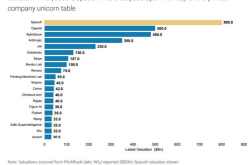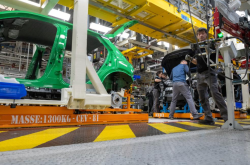When AI Q&A Replaces Search: Will Brands Still Resonate?
![]() 07/31 2025
07/31 2025
![]() 518
518
In the digital realm, who will be the voice of the brand?
By Wang Jianfan, ECNS
'Fading from AI's sight' is becoming a stark reality for numerous brands.
Users no longer navigate browsers to search but directly pose questions to ChatGPT, Deepseek, or Doubao, inquiring about the best small appliances or top brands in a specific industry. It's no longer the brand's heavily invested official websites, encyclopedias, or advertisements that respond, but the outcomes generated within a 'black box' by large AI models.
The manner in which brands engage with users is evolving. The traditional traffic logic aimed to secure a spot on the first page of search results; now, numerous brands are absent from AI Q&A, lost in the vast ocean of data.
The entry point for the marketing industry is also undergoing a transformation. Data from Similar Web reveals that nearly 69% of search behaviors among American users do not result in redirects, with answers being procured directly on the search results page. The Chinese market likewise demonstrates a strong inclination towards 'zero clicks,' with AI summaries and Q&A supplanting blue links as the primary entry point.
Brands must confront a novel challenge: how to remain visible in an era where they are not actively searched for.
Part 1: From SEO to GEO
In late July, Microsoft updated its browser, introducing the 'Copilot Mode' on the default homepage. Users no longer need to redirect searches; they can ask questions directly in the browser, with AI integrating tab content to provide comparisons, analyses, and operational suggestions.
The deeper context of this shift is the complete AI-ification of the search industry: search is no longer a path to information but a process facilitated by AI.
This is the industry-wide direction. In March this year, Google expanded its AI search function, displaying results purely through AI-based search without traditional links.
In China, experiments with AI search are progressing rapidly. Baidu has introduced question-and-answer search results based on ERNIE Bot, with 'summary answers' partially replacing blue links. ByteDance has integrated a smart search interface within Doubao, aiming to connect short content with search needs. Players like MetaMind, explicitly targeting search engines, are also accelerating technological iteration, striving to secure a position in this AI search race.
The common denominator of these platform changes is that AI no longer links to web pages but directly generates answers from diverse corpora. In this process, brand content is reorganized by machine logic, such as 'whether to invoke,' 'how to cite,' and 'which sentence to place it in,' rendering traditional SEO (search engine optimization) tactics largely ineffective.
Amidst this wave, GEO (generative search optimization) is swiftly gaining traction. According to Toubao Research Institute, the GEO market size is projected to reach approximately 2.1 billion yuan by 2025, just one-tenth of SEO. However, with the rapid proliferation of AI Q&A entry points, this figure is anticipated to leap to 24.2 billion yuan by 2027, surpassing SEO.
Unlike traditional SEO, the essence of GEO lies not in page structure or keyword distribution but in whether content can be recognized, trusted, and invoked by large models. In essence, brands need to increase their 'probability of existence' in model answers rather than enhancing their position in search results.
Factors influencing this probability typically encompass three aspects: the clarity of information structure, its proximity to the expression mode of model corpora, and the presence of credible sources and citation chains.
While the past focused on 'page crawling' optimization, the current focus is on 'semantic understanding.' This signifies that GEO is not an extension of SEO but a ground-up rebuild of content strategies. It represents a new interface between brands and AI models and the starting point for enterprises to redefine their cognitive positions within the generative ecosystem.
Part 2: From 'Being Searched' to 'Being Understood'
The concept of GEO is gaining acceptance among brands, yet only a few players have truly established comprehensive strategies and product systems. This necessitates both understanding and engineering expertise.
In the search engine era, a brand's 'visibility' was contingent on the research and application of search mechanisms, such as keyword optimization, content layout, backlinks, etc. However, in a generative context, brands confront an 'invisible' and 'uncontrollable' language model system, rendering previous experience largely untransferable. Brands require a novel technical approach to ensure accurate description and preferential citation in AI's 'mind.'
Frank, Chief Strategy Officer of Yuanli Technology at A+ Marketing Group, emphasized in a conversation with ECNS that 'GEO and traditional SEO are fundamentally different. Traditional SEO relies on understanding search engine rules, such as enhancing website rankings through keyword optimization. In the AI era, the challenge for brands is to ensure their content is recognized and preferentially cited in complex AI reasoning.'
He further elaborated that brands must transcend the keyword optimization of traditional SEO and adopt a 'semantic understanding'-centric strategy to ensure visibility and accurate comprehension within a generative AI environment.
However, this transition is no mean feat. Lingrang, General Manager of the GEO Business Department at Yuanli Technology, added, 'While more companies are exploring GEO, many still rely on traditional SEO methods, with brand owners providing keywords and service providers optimizing them. This approach may yield short-term exposure but fails to foster a long-term and healthy AI cognition system for the brand.'
The current market confusion stems from this transitional phase. Frank noted, 'Some GEO providers may adopt a 'quick results' mindset, attempting to boost exposure through numerous diluted articles or external links. This not only pollutes the AI's knowledge environment but also hinders brands from establishing genuine long-term connections with users.' This phenomenon not only distresses brand owners but also exposes the industry to a climate of quick success and instant benefits.
As brands gradually recognize this, standing out in the complex generative AI landscape has become their focal point. True long-term value stems not from simple technical adjustments but from a profound resonance among brands, customers, and AI.
In this regard, iPowerAI's iGeo large model presents a unique perspective and breakthrough. Unlike many GEO solutions targeting short-term effects, iGeo's strength lies in its deep construction based on a multi-agent cluster and AI intent neural network, enabling brand information to be recognized and preferentially presented for an extended period within a multidimensional AI ecosystem. This influence transcends mere 'visibility,' deeply ingraining itself in AI's understanding of the brand, affording the brand unique memory points in AI's eyes.
On the customer side, iGeo not only focuses on short-term brand exposure but also aims to achieve far-reaching marketing effects by constructing the brand's 'intent economy.' Frank illustrated, 'GEO should not merely address explicit demands like 'which affordable electric toothbrush is good' but should naturally elicit brand content when users express 'toothache.'
This transcends mere technology application, embodying a profound understanding and response to 'user needs.' Through iGeo, brands can transition from addressing 'explicit needs' to deeply exploring 'potential needs,' integrating brand content into users' scenarios and being displayed at the right time and in the appropriate context.
This is the crux of GEO's path towards 'long-term value' – not merely securing the priority of a single answer but fostering a deeper understanding between brands and users within a continuously evolving AI context. From 'being searchable' to 'worthy of being understood,' from one-time exposure to continuous cognition, the ultimate goal of GEO is not merely optimizing model invocation logic but making brands something that AI actively remembers and users naturally trust.
Conclusion: To Be Seen, or to Be Forgotten?
We stand at a crossroads shaped by code. As AI's 'black box' becomes the new gateway to the world, a brand's existence is no longer defined by the intensity of its exposure but by the depth of its imprint within the vast data landscape.
In an era where traffic dominates, brands have become accustomed to shouting their wares. In the AI-dominated future, brands must learn to be calm and profound storytellers rather than blind trademark shouters.
Because at the heart of this transformation, true 'visibility' is not fleeting exposure but a lasting and indelible memory, a cognition and trust deeply embedded within AI's 'black box.'
The answer to this question extends beyond timeless values or beautiful stories.
It is also an engineering challenge that urgently needs addressing. Brands require professional navigators to systematically transform their unique value and profound stories into deep memories that AI can recognize, understand, and preferentially cite, leveraging new-generation technological concepts like GEO.
Ultimately, this boils down to a fundamental question: in this world intricately woven with information and algorithms, are you prepared to face the scrutiny of the AI era? Can your brand be understood, remembered, and trusted by AI? (Produced by SWMF) ■
Source: ECNS






